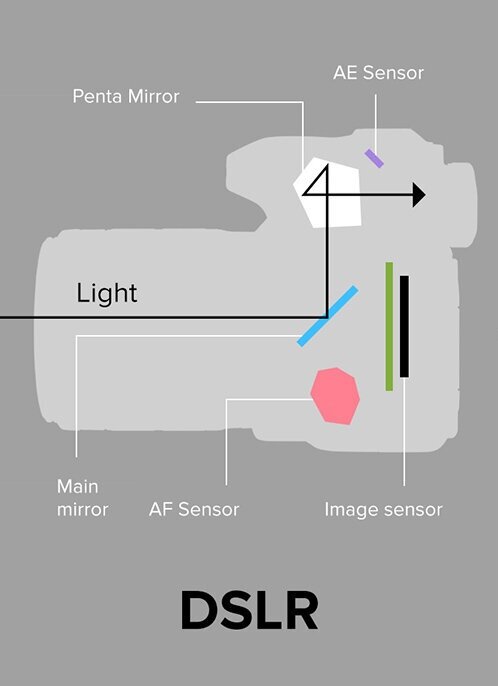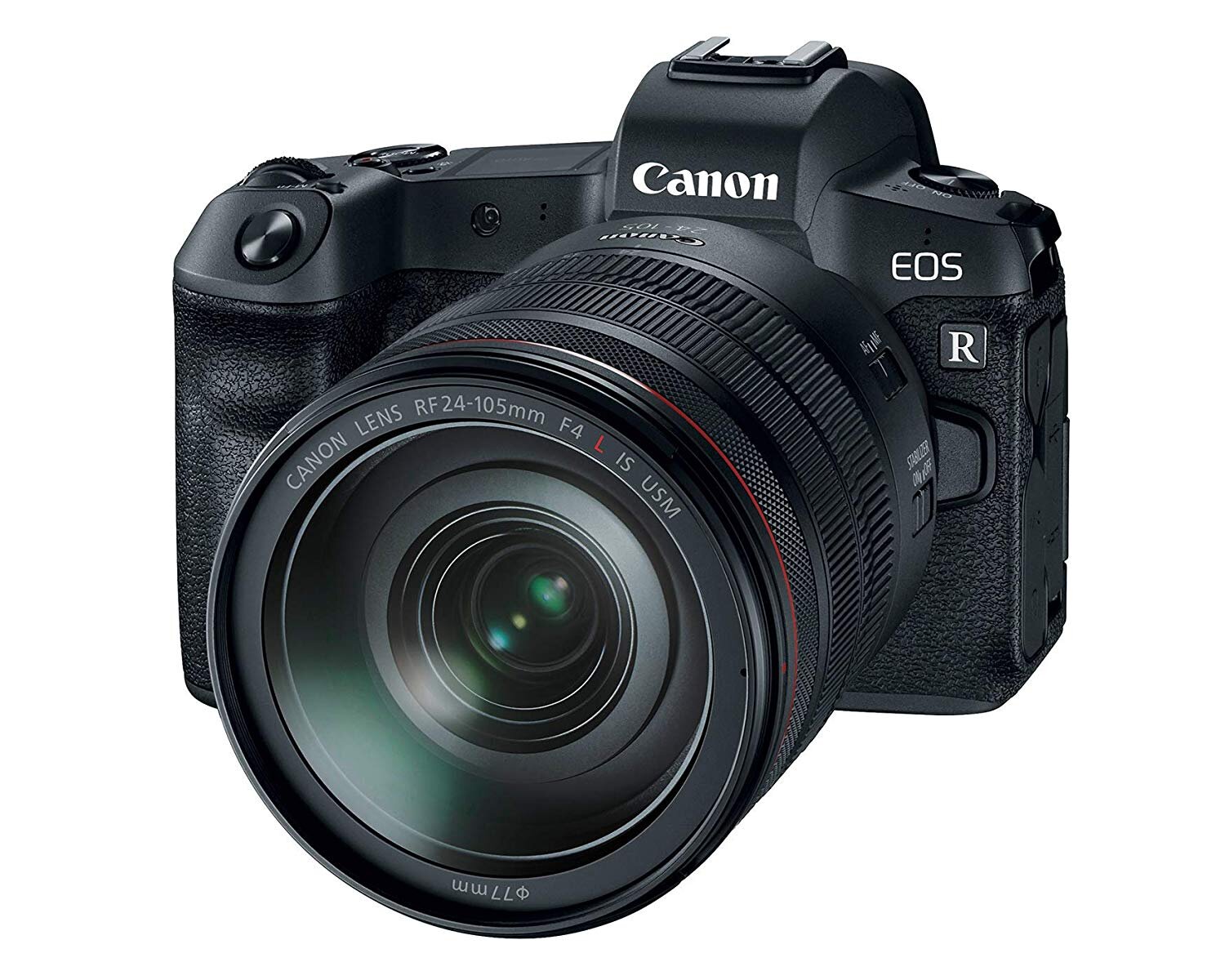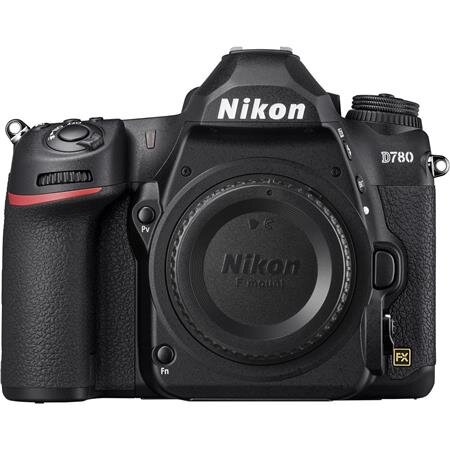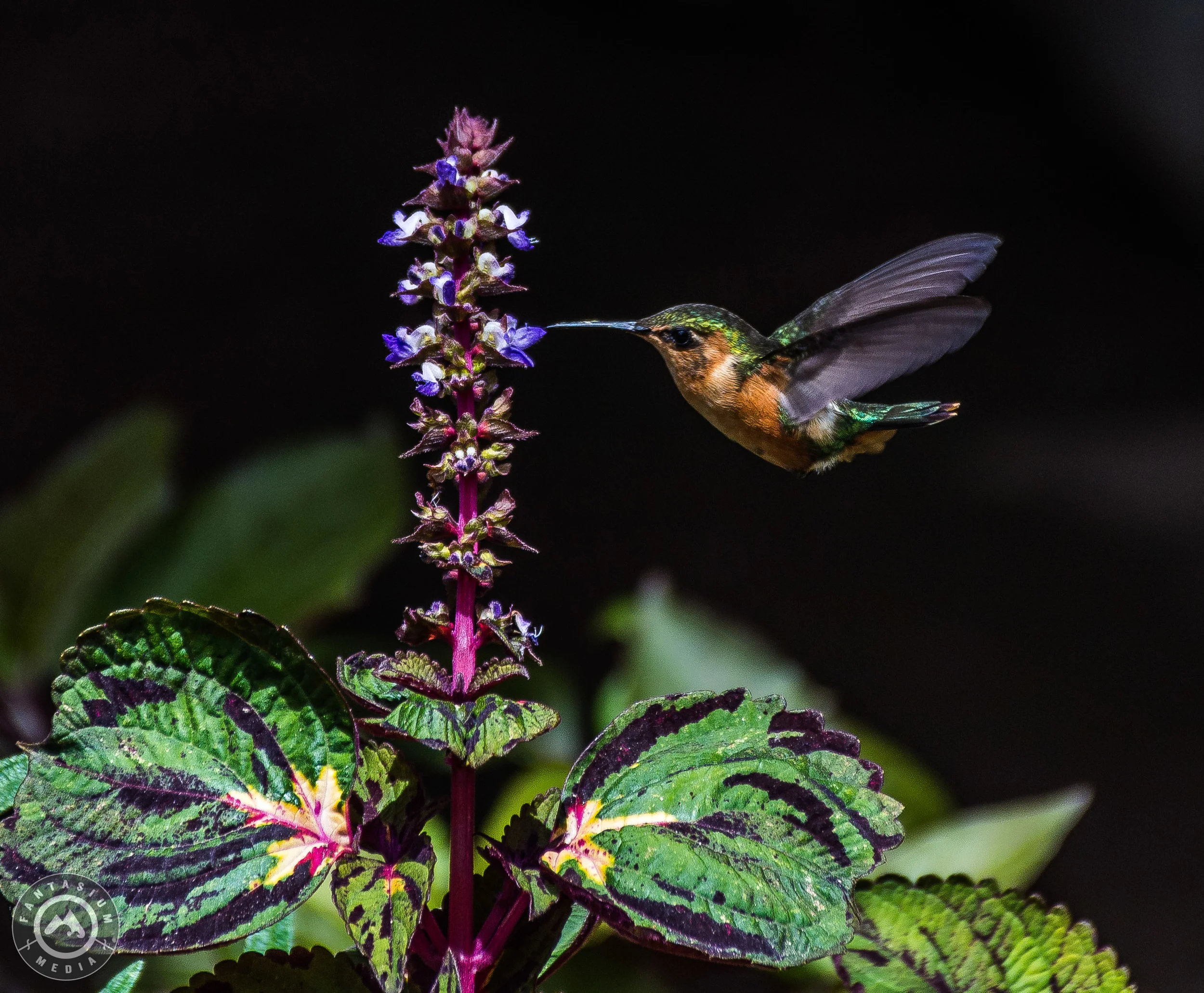Photography 101: Mirrorless vs. DSLR
When someone goes out to purchase a new camera, one of the first things that they will be asked (or find when researching on the internet) is should you go with a mirrorless camera, or a DSLR camera?
These two types of cameras operate in similar ways, but have key differences that can help you choose between different camera models and ensure that you go with the camera that is right for you. This article will quickly go over those main differences without going into too much technical detail. Along the way we will also make some recommendations of different camera systems so you can get an idea of what your options are.
What is a DSLR Camera?
DSLR stands for “Digital Single Lens Reflex”. Single Lens Reflex is the technology that has been used in film cameras for decades. It incorporates using a mirror and a prism system that allows the photography to view that they are capturing and write that data to a specific medium. DSLRs work exactly the same way as film SLRs did, except that their medium is a digital file rather than a roll of film.
Before a photograph is taken, a DSLR camera takes in light, reflects that light through a mirror system, and projects that light through an analog viewfinder. This allows the photographer to compose an image before capturing it. When the shutter button is pushed, the shutter closes which blocks the mirror and allows the light to be absorbed by the sensor. The sensor then takes the light in, and writes what it “sees” as data to a digital file.
What is a Mirrorless Camera?
A mirrorless camera works in the exact same way as a DSLR, except that it does not contain a mirror system, hence the name. Light passes directly onto the sensor without passing through the mirrors.
Most people are more familiar with mirrorless cameras than they think - all cell phone and point and shoot cameras without analog viewfinders are mirrorless systems that allow the user to capture an image by composing it using the small sensor in the phone or camera. These cameras use smaller sensors that your standard Interchangeable Lens Camera (ILC) which allows them to be packed into extremely compact devices.
Differences Between Mirrorless and DSLR Cameras
When we discuss the differences between DSLR and mirrorless cameras we are referring to the differences between Interchangeable Lens Camera (ILCs) that utilize the two systems. The biggest difference is - you guessed it - the mirrorless camera does not have a mirror, and the DSLR does.
However, that small engineering difference creates many nuances that are important to know, especially when you are choosing between a mirrorless or DSLR ILC.
Size and Weight
One of the differences you’ll notice right away when viewing the two options side by side is the size of the cameras. Pick one up in each hand and the weight discrepancy will be noticeable. Due to the fact that the mirrorless camera is indeed without a mirror, that allows producers of cameras to save on space and weight with the elimination of that component. Having a smaller camera is especially handy if you are limited on space / weight.
For some, a bigger camera can be better. Depending on the size of your hands and personal preferences, a larger DSLR might fit you better ergonomically. Despite all of the technical terms and specs that get thrown around today, the feel of a camera in your hand is still an incredibly important factor.
Viewfinders and Live View
As previously mentioned, in a DSLR camera the mirror reflects the image that the camera is “seeing” and projects it into the viewfinder. Since this is not operated electronically, the image that you see in a DSLR viewfinder is true to the image that you would see if you were to look at the subject with your eyes. You can also use a DSLR viewfinder when the camera is off. This can be useful for saving battery while composing your images.
Mirrorless cameras use an electronic viewfinder that actually shows you how the image will appear when you take it. On a mirrorless camera, if you make adjustments to the settings, your electronic viewfinder will adjust the image that is displayed based on the amount of light that it is able to take in. This means that you don’t need to review the image each time to ensure your exposure triangle settings are configured correctly.
Autofocus
In the past DSLRs had the edge here due to the technology they utilized called Phase Detection AF. Without going into too much detail, this feature basically allowed DSLRs to focus more effectively on moving subjects, which is huge in things like sports and wildlife photography.
Newer mirrorless models now have the phase detection AF built into the sensor which allows them to retain their compact size while matching DSLRs step for step with their AF capabilities. Cameras like the Sony A7 series have improved autofocus systems that are quickly making them the go to tool for situations that require highly refined focusing capabilities.
Focus Peaking & Focus Assist
These are two of my favorite features that mirrorless cameras provide. Because you have a live view of the image you are taking (remember, mirrorless shows you exactly how the photo will turn out in the viewfinder and view screen), this expands the features that these cameras are equipped with when focusing on subjects.
Focus peaking is the first of these. What this allows you to do is look at your camera viewfinder or live vie wand confirm that a subject is in focus. When the subject is focused correctly, a smattering of color will appear around the subject. This can be helpful when shooting fast moving subjects, and you can’t question whether or not that subject is in focus or not.
Focus assist is probably my favorite feature that sets mirrorless cameras apart. When you are using the manual focus on a lens, the viewfinder or view screen will magnify a specified point on your subject, allowing you to get an ultra close up view of the fine details that you need to ensure are in focus. This is huge for macro and wildlife photography and can be a valuable tool for things like astro and portrait photography as well.
Continuous Shooting Speeds
On a DSLR, you have a shutter that needs to close and open again between shots. This is the notorious “click” sound that you hear on most camera models. More on this noise later - but when it comes to shooting speeds, this means that the DSLR needs to close this shutter to block the mirror and process data to the sensor, then open again so you can see the frame, then close again…you get the picture (ha) .
Because light passes directly through the lens to the sensor, mirrorless cameras do not have to worry about opening and closing a shutter, which in turn allows them to shoot faster. Most mirrorless models can easily hit 10 fps, with some models like the Sony A9 allowing for a staggering 20 fps. These speeds aren’t always necessary, but can be crucial depending on the type of photography.
Battery Life
Due to the electronic nature of the view screen and viewfinder, mirrorless cameras inherently utilize more battery than DSLRs. I could go days without charging my Nikon D7200 - with the new Sony A7R IV, I used pretty much a full battery after shooting for a day. This is without recording any video or long exposures - functions such as those would utilize even more battery.
When thinking about your activities and how much access you’ll have to charging stations, battery life for the two camera types is definitely an important factor to take into consideration.
Sound
We learned earlier that mirrorless cameras lack the shutter that is contained in a DSLR unit. This not only allows mirrorless cameras to shoot faster than DSLRs, but it eliminates the “click” sound that you hear when you snap a photo. This can be very useful in situations where it’s important to keep a low profile like weddings or even animal photography.
Now, I definitely understand that some people enjoy the satisfying shutter sound - I’m one of those people as well! Thankfully, most mirrorless cameras come with a silent shooting option that you can use to toggle the shutter sound on or off.
Video Recording
DSLR cameras have long been the go to choice for professional videographers - but debatably only because they were there first. With a DSLR camera you usually will need to plug in an external monitor to ensure your settings are configured appropriately, and the autofocus on lower to midrange DSLR models can be less than effective.
Mirrorless cameras show your video setting adjustments in real time, and most models come equipped with powerful video autofocus capabilities, especially newer mirrorless cams. They all also usually shoot 4k, a standard in today’s videography world.
Camera Features
This isn’t so much a difference as a quick point that is important to cover - most DSLR ILCs will have similar if not the same features as a mirrorless ILC. Mirrorless cameras tend to be newer models, so often the mirrorless cameras might have the advantage here just based on the fact that they can utilize newer technology that is becoming standard for ILCs across the board.
Lens Options
Due to the previous dominance of DSLR cameras it used to be that lenses for mirrorless ILCs were lacking in options and even sometimes downright hard to find. This is not so anymore - with the emergence of modern mirrorless cameras both the camera manufacturers and 3rd party lens companies like Tamron and Sigma have been hard at work developing new lenses specifically for mirrorless cameras.
Price Point
Finally we get to the topic that most camera buyers know even before they start their search - how much they are looking to spend.
Professional and prosumer ILCs, whether DSLR or mirrorless, will usually run close to the same price points for comparable models. As an example, at the time of writing this, the new Canon EOS 5DS DSLR retails for $3500, which is the exact same price as the mirrorless megapixel monster Sony A7R IV. Depending on what you’re looking for there are great selections of both camera type available. The advent of some of this new technology could be a benefit to photographers who take the opportunity to seek out a used or “old” model of a new cameras predecessor - often you can find a camera with very similar capabilities for a fraction of the price!
Final Verdict: Mirrorless or DSLR?
In photography the camera that we use is simply a tool that completes an objective. These objectives can range from commemorating an occasion to completing a paid assignment that has very specific output requirements. Whether a mirrorless camera or a DSLR camera, there will always be a time when one is suited better for the task at hand than the other. At the end of the day, it’s important to take into account the features of each camera type and select the model that is best for your needs.
Another huge factor to take into account are your lenses. An ILC is (literally) nothing without a lens, and in most cases a top of the line lens on a lower end camera will produce better results than a low end lens on a top of the line camera.
That being said, camera manufacturers are putting a huge emphasis on mirrorless cameras so there is a strong chance that a huge number of the accessories and resources that are researched and released are targeted towards mirrorless users. Despite the fact that each camera has its benefits, mirrorless cameras are definitely all the rage at the moment!
Comparable ILC Options for All Levels of Photography
So, you’ve gotten the gist of the differences between the two - now, let’s explore several great camera options for all levels of photography experience.
Note: I was not compensated in any way for the following recommendations and opinions.
Entry Level: Those New to Photography
Nikon D3000 series, Canon Rebel series, Sony a6000 series
I think it’s safe to say that these three models have the entry level market pinned down, and with good reason. Each one of these cameras sports outstanding features and technology that will make them easy for someone upgrading from a cell phone or a point and shoot camera to use right out of the box. They all also can be purchased as a kit that includes a close to midrange lens as well as a zoom lens. It’s important that we don’t overlook the fact that these are powerful machines, even at the entry level. Each of these crop sensor models offers full manual shooting and advanced features, which allows beginning photographers to grow with their camera and can even provide advanced shooters and professionals with a solid backup camera or even main camera, as long as they are paired with the correct lens.
Midrange: Photographers Looking to Upgrade From Their First Camera
Nikon D7000 Series, Canon EOS 80 or 90D, Sony A6400 - A6600
When a photographer is ready to upgrade from their first camera it’s usually because they have started (attempting) to shoot things that they just can’t capture the way they want with their current camera. Maybe they are looking to shoot wildlife and their FPS isn’t fast enough, or they have been shooting landscape and just aren’t getting the detail they want from their base level sensor. Each one of these models with a lens will break the $1000 price point, and with good reason. We’re still in crop sensor territory, but besides that these are semi-professional cameras that are suited to a myriad of different shooting types. Add in some top of the line lenses to one of these bad boys and you’ve got yourself a mean shooting machine.
Prosumer: Shooters Who Know Their Stuff
Nikon D780, Canon EOS R, Canon EOS 6D Mark II, Sony A7R II, Sony A7R III
Now we’re getting into the full frame lineup of premium cameras. Once you break this barrier you’re looking at powerful cameras that can meet the needs of both serious hobbyists and professionals alike. These will all have top of the line technology paired with extensive camera features and high end lenses. The jump from crop sensors to full frame is usually worth it for most photographers when looking at one of these cameras or another model that is similarly equipped.
Professional: The Best of the Best
Nikon D850, Canon EOS 5D IV, Sony A7R IV, Nikon Z7
These cameras mean business. Equipped with the best of the best technology and a price point to match, this lineup is geared towards professionals who need top of the line performance from their cameras with each and every shot. All of these are full frame cameras and can be paired with top of the line lenses to serve every need with crispness, clarity, and quality.
Moral of the story - whether you go mirrorless or DSLR, cameras these days all utilize incredible technology and are capable of capturing stunning images. Your best bet is to go and talk with a knowledgeable professional and communicate exactly what you are looking for and what you want to shoot with your new camera, and they will be able to give you solid recommendations for a camera body, lenses, and accessories. If you’re in the market for a new camera feel free to reach out and I would be happy to point you in the right direction!






























